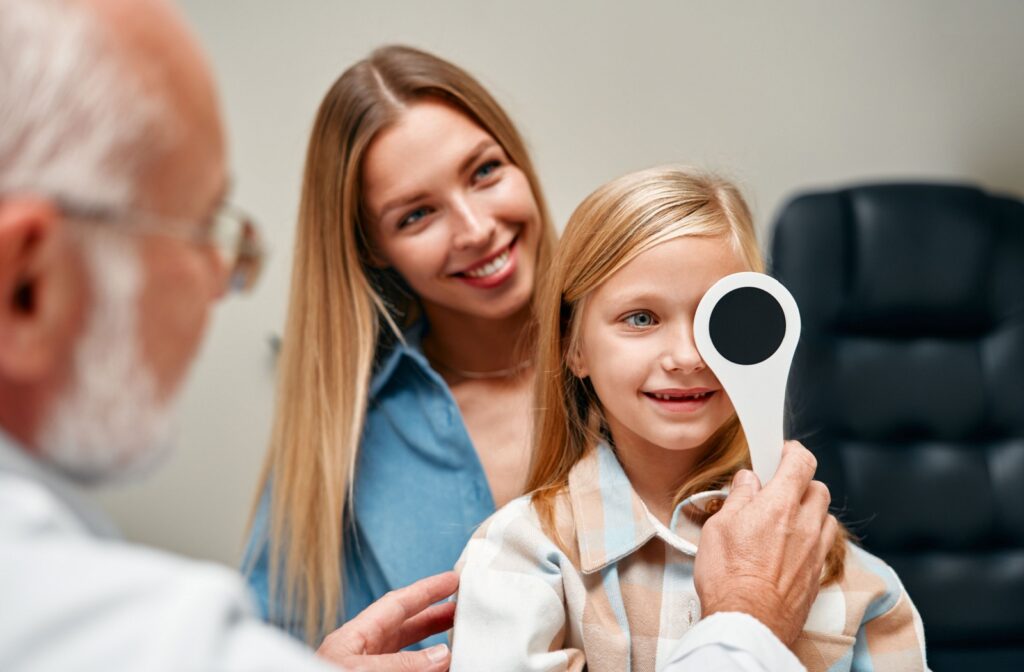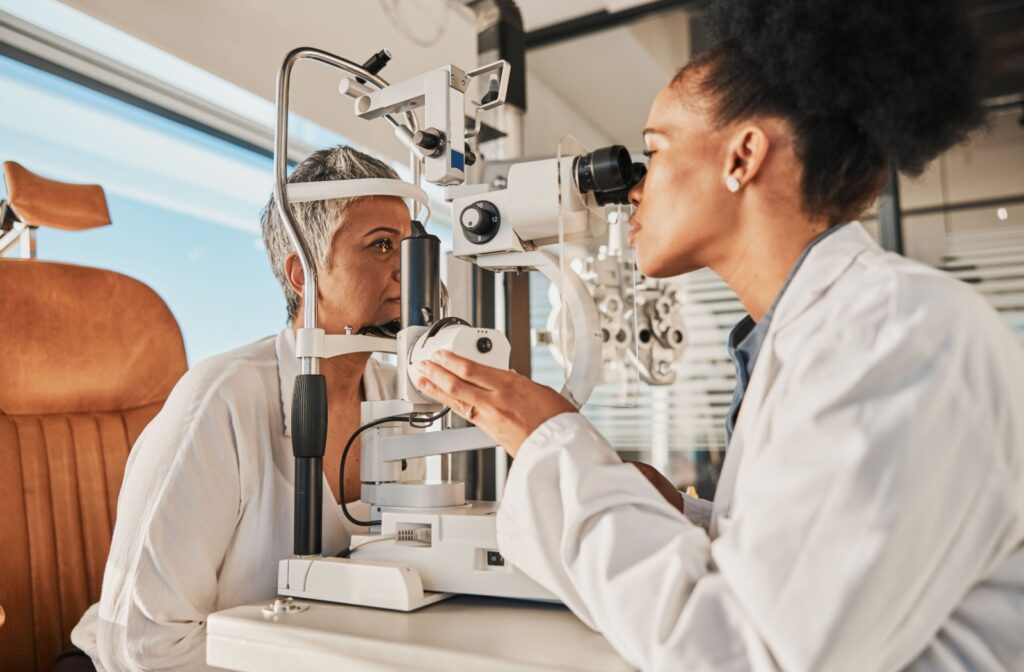Blurry vision, headaches, and eye strain are all signs that suggest it might be time for a visit to the eye doctor. But routine exams encompass so much more than updating your vision prescription.
Routine eye exams offer comprehensive insights into your eyes’ overall health, making it easier to detect potential concerns early.
These are the tests you can expect to have during a routine eye exam:
- Preliminary screening
- Visual acuity test
- Refraction exam
- Eye muscle function test
- Pupil response check
- Slit lamp examination
- Intraocular pressure measurement
- Retinal exam
Just as you visit your family doctor and dentist for routine check-ups, stay on top of your visual health with routine eye exams!
Why Do You Need a Routine Eye Exam?
Routine eye exams are vital for maintaining good vision and eye health. These visits can identify vision concerns, detect early signs of eye diseases, and even reveal systemic health conditions like diabetes or high blood pressure.
Even if you don’t need glasses, routine eye exams are beneficial for everyone. Although the frequency of these visits varies depending on age, vision concerns, and overall health, a general rule is:
- Children (19 and under): Annual exams are needed to monitor changes in children’s vision as they grow. They can have their first exam as early as 6 months!
- Adults (20-64): Annual eye exams are a great way to support your overall eye health. However, most people can get by with an exam every 2 years, depending on their vision concerns and general health.
- Seniors (65+): Older adults are more likely to develop age-related vision conditions, making annual visits crucial for early detection.
In certain cases, your optometrist will recommend more frequent visits, especially if you have diabetes, a family history of eye diseases, or wear contact lenses.
In very young children, eye exams check for proper visual development. Uncorrected concerns, like refractive errors or a lazy eye, can hinder learning and performance in school.
Besides, young eyes are more responsive to treatment!
What Happens If You Skip A Routine Eye Exam?
Skipping a routine eye exam might not seem like a big deal, especially if you don’t have any concerns. But eye exams are your first line of defense.
Several eye conditions, like glaucoma and macular degeneration, can develop silently, often without noticeable symptoms until the disease progresses. Skipping an eye exam could mean delaying treatment, putting your vision at risk.
Your Guide to Routine Eye Exam Tests
A comprehensive eye exam involves a series of tests to evaluate your vision and eye health. Each test serves a specific purpose. Together, they create a complete picture of your eye health so that nothing is overlooked.
From preliminary testing to the final prescription (if you need one), here’s what to expect during your visit:
Preliminary Tests
Your visit begins with preliminary testing to gather general information about your eye health and provide a baseline for the rest of the exam:
- Depth Perception: How accurately you perceive distances.
- Colour Vision: How well you can distinguish between different colours.
- Eye pressure test: We use an instrument called iCare to gently measure the pressure inside your eyes, an important screening for glaucoma. While the device briefly touches the surface of your eye, most patients find it quick and minimally uncomfortable.
- Auto-refraction: This gives the doctor an estimate of your vision prescription and is further refined inside the exam room.
- Retinal Images: We use modern imaging tools like OCT scans and retinal photos to capture detailed pictures of your eye’s internal structures.

Visual Acuity Test
In the exam room, you’ll find the infamous eye chart (Snellen chart), which shows a series of letters that get smaller the further you go.
This test measures your ability to distinguish letters or symbols from a specific range. The results guide us in understanding your baseline vision and whether you need corrective lenses.
Refraction Test
When we show you a series of lens options and ask which of the two is better, this is a refraction test.
Your response guides us toward finding the lens that provides the sharpest vision. This helps determine your final vision prescription (if you need one).
Eye Muscle Function Test
Your eye muscles are critical for proper vision, and this test evaluates how well they work together.
We’ll ask you to follow a light or an object with your eyes in various directions. This helps identify conditions like strabismus (misaligned eyes)..
Pupil Response Check
This test assesses how your pupils respond to light and darkness.
We will shine a light into your eyes to check if your pupils dilate and constrict appropriately. Abnormal responses can signal underlying neurological or eye conditions.
Slit Lamp Examination
A slit lamp machine allows your eye doctor to examine the front structures of your eye, including the cornea, iris, and lens, using a strong magnifying lens and light.
This test is used to detect cataracts, corneal damage, or any abnormalities on the eye’s surface.
Retinal Exam
We will evaluate the retina, optic nerve, and blood vessels at the back of your eye. Then, we’ll explain the findings of the retinal images taken earlier during your visit.
Sometimes, this portion of the exam might include a dilation test, especially if we want to take a closer look at these internal structures.
We use special eye drops to widen your pupils and look for any signs of retinal conditions, diabetic retinopathy, or even systemic health concerns like high blood pressure.
Safeguard Your Sight
Taking the time out of your busy schedule for an eye exam is always an investment worth making.
Routine exams are a way to stay ahead of your health. Identifying concerns early facilitates timely management for better results. Supporting your vision and eye health has never been easier. Whether it’s your first eye exam or a while since your last visit, our Lowy & Sewell Eye Care team is here to support you. Connect with our team to book an appointment.



